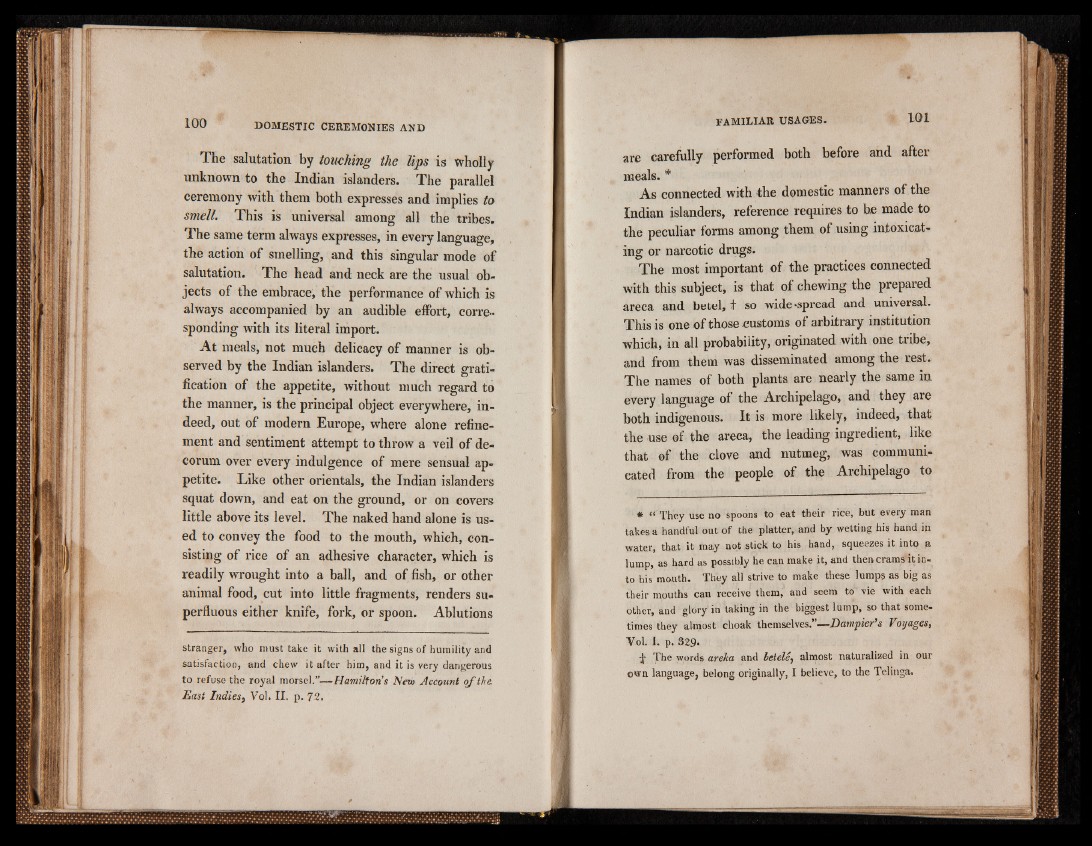
The salutation by touching the lips is wholly
unknown to the Indian islanders. The parallel
ceremony with them both expresses and implies to
smell. This is universal among all the tribes.
The same term always expresses, in every language,
the action of smelling, and this singular mode of
salutation. The head and neck are the usual objects
of the embrace, the performance of which is
always accompanied by an audible effort, corresponding
with its literal import.
At meals, not much delicacy of manner is observed
by the Indian islanders. The direct gratification
of the appetite, without much regard to
the manner, is the principal object everywhere, indeed,
out of modern Europe, where alone refinement
and sentiment attempt to throw a veil of decorum
over every indulgence of mere sensual appetite.
Like other orientals, the Indian islanders
squat down, and eat on the ground, or on covers
little above its level. The naked hand alone is used
to convey the food to the mouth, which, consisting
of rice of an adhesive character, which is
readily wrought into a ball, and of fish, or other
animal food, cut into little fragments, renders superfluous
either knife, fork, or spoon. Ablutions
stranger, who must take it with all the signs of humility and
satisfaction, and chew it after him, and it is very dangerous
to refuse the royal morse].”— Hamilton's Neio Account o f the.
East IndieSf Vol. II. p. 72.
are carefully performed both before and after
meals. *
As connected with <the domestic manners of the
Indian islanders, reference requires to be made to
the peculiar forms among them of using intoxicating
or narcotic drugs.
The most important of the practices connected
with this subject, is that of chewing the prepared
areca and betel, + so wide spread and universal.
This is one of those customs of arbitrary institution
which, in all probability, originated with one tribe,
and from them was disseminated among the rest.
The names of both plants are nearly the same in
every language of the Archipelago, and they are
both indigenous. It is more likely, indeed, that
the use (ftf the areca, the leading ingredient, like
that of the clove and nutmeg, was communicated
from the people of the Archipelago to
* * They use no spoons to eat their rice, but eveiy man
takes a handful out of the platter, and by wetting his hand in
water, that it may not stick to his hand, squeezes it into a
lump, as hard as possibly he can make it, and then crams it into
his mouth. They all strive to make these lump? as big as
their mouths can receive them, and seem to vie with each
other, and glory in taking in the biggest lump, so that sometimes
they almost choak themselves.’ —Dampier’s Voyages,
Vol. 1. p. 329*
•J- The words arelca and betele, almost naturalized in our
own language, belong originally, I believe, to the Telinga.